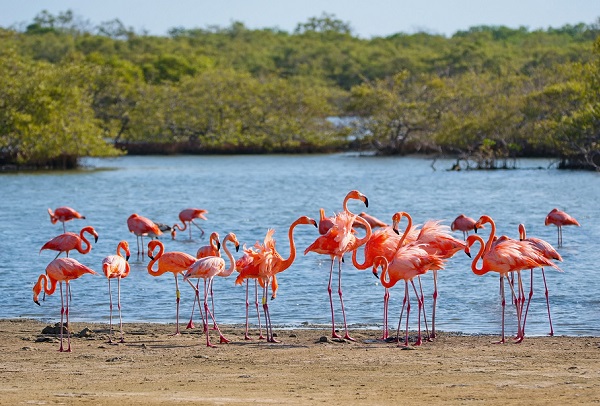

[Many thanks to Peter Jordens for bringing this item to our attention.] Kira Richards (National Geographic Traveller, UK) explores places to go for animal watching in the Caribbean: “The sultry interiors of the Caribbean islands are a veritable haven for tropical wildlife. From giant butterflies in Jamaica to ancient iguanas in the Bahamas, see the region at its most untamed.” Here are excerpts, for full article and breathtaking photos, visit National Geographic.
The verdant rainforests, volcanic hills, steep valleys and rippling crater lakes that make up the interior of Caribbean are often overlooked in favour of its coastline. But head into its humid heartland for a taste of the wild. Within these jungles, fauna thrives, guarded by local conservationists who, for decades, have strived to establish protected areas and enforce anti-poaching policies. There are also countless places to observe Caribbean wildlife in its natural environment; mona monkeys swing between the trees of Grenada’s largest national park, scaly iguanas sunbathe on islets in the Bahamas and flamingos strike their perfectly pink poses in Bonaire. Here’s where to witness some of the region’s most exciting animals in six of its wild island destinations.
1. Grenada: mona monkey
Originally from West Africa, monas were brought to Grenada in the 18th century on colonial ships, perhaps as pets, or possibly even by complete accident. The only species of monkey found on the island, they’re known among locals for their sociable personalities, booming voices and lithe, plasticine-like limbs. Their faces — blue-grey and surrounded by fluffy white beards — are extremely expressive, with wide black eyes giving them a near-constant look of surprise. Grand Etang, the largest national park in Grenada, sprawls more than 3,000 acres of luscious forest with a 20ft-deep crater lake, a collection of seven thrashing waterfalls and a zipline slicing through the trees. This reserve is the mammal’s main home, so while trekking through the park, don’t forget to look up.[How to do it . . .]
2. Bonaire: flamingo
The Caribbean’s candyfloss-pink flamingos are almost impossible to miss. The three former Dutch colonies of Aruba, Bonaire and Curaçao — known as the ABC islands — are great places to see the birds. Flamingos here are some of the largest and brightest in the world, often found dipping their webbed feet in shallow seawater. At the Gotomeer lagoon on Bonaire, you can expect to witness a squawking army of flamingos. It’s one of four salt ponds, known as salinas, in Washington Slagbaai National Park — a reserve that spans one fifth of Bonaire’s 111sq miles, and perhaps the best place to see the birds as they gather in gaggles of 50 or more. [How to do it . . .]
3. Jamaica: giant swallowtail butterfly
With a wingspan measuring a staggering six inches, the Jamaican or Homerus giant swallowtail butterfly is one of the largest and most striking butterflies found in the Americas. The species has a specific yellow-and-black pattern and colourway featuring tinges of orange on the outer edges, and is endemic to Jamaica, flitting lazily through its impenetrable rainforests. Though sightings of the swallowtail — safeguarded by Jamaica’s Wildlife Protection Act — can be fleeting, the trek through the nation’s heartlands is worth the voyage regardless. The Troy-Windsor Trail — which crosses through more than 10 miles of the rugged Cockpit Country — snakes its way over hills and deep into valleys. [. . .] Make sure to go with a guide who knows the area for this endurance-testing hike, though it’s less necessary for the one-hour Windsor Loop, which traverses a shorter, three-mile section of the full trail. [How to do it . . .]
4. The Bahamas: iguana
Covered in small, sparkling scales in shades spanning from deep onyx to pale pink, the Bahamian rock iguana is famed for its distinct colouring, which differs from the vibrant green hue of many of its South and Central American counterparts. The population is endangered, with around 5,000 left in the wild, most of which live on just two archipelagos of the Bahamas’ 700-plus islands, islets and cays. Stringent habitat protection is helping bolster numbers, however, so for a chance to spot them, head to Andros Island and the Exumas, where the iguanas can often be seen dashing along silky, tide-washed stretches of sand, their elongated tails curving slightly towards the sky. [. . . How to do it]
5. Trinidad and Tobago: scarlet ibis
Easily recognisable due to its striking red feathers fringed with black tips, the scarlet ibis is Trinidad and Tobago’s national bird, echoing the country’s red flag with a black and white diagonal sash. It gets its colour from a diet consisting largely of crab and is known for its penchant of picking its way daintily across wetlands and mudflats. To spot the birds, head to Caroni Swamp, Trinidad’s largest mangrove forest, covering 40 square miles of wetland on the island’s west coast. Characterised by its serpentine waterways hemmed with overgrown shrubs, Caroni Swamp and its adjacent bird sanctuary were made into a reserve in 1953, and over the seven decades since, conservation efforts have continued to protect and grow the scarlet ibis’s population in the region. [. . . How to do it]
6. St Vincent & The Grenadines: St Vincent parrot
Look out for flashes of golden yellow, admiral blue and deep emerald as the St Vincent parrot soars above the country’s verdant peaks. Although the bird — which mirrors the colours of the national flag — is a mere 16 inches long, its squawk is mighty, reverberating through the wilderness. St Vincent & the Grenadines is a country comprised of 32 islands and cays, but almost all the wild parrots reside on the largest island of St Vincent, nesting in the island’s 50-plus square miles of untamed rainforest. There are only around 850 of the colourful fliers left, the population dwindling due to deforestation and illegal trading, but conservation initiatives like Birds Caribbean are working tirelessly to prevent numbers slipping further. Head along the Vermont Nature Trail to spot them. [. . . How to do it]
For full article, see https://www.nationalgeographic.com/travel/article/where-to-see-the-caribbeans-rarest-animal-residents
[Photograph above by Tunatura, Getty Images: Within the Caribbean’s jungles, fauna thrives, guarded by local conservationists who, for decades, have strived to establish protected areas and enforce anti-poaching policies.]
[Many thanks to Peter Jordens for bringing this item to our attention.] Kira Richards (National Geographic Traveller, UK) explores places to go for animal watching in the Caribbean: “The sultry interiors of the Caribbean islands are a veritable haven for tropical wildlife. From giant butterflies in Jamaica to ancient iguanas in the Bahamas, see the





